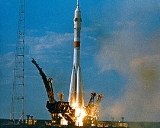
Soyuz-U2
Encyclopedia
The Soyuz-U2 was a Soviet
, later Russia
n, carrier rocket. It was derived from the Soyuz-U
, and a member of the R-7 family of rockets. It featured increased performance compared to the baseline Soyuz-U, due to the use of syntin
propellant, as opposed to RP-1
paraffin, used on the Soyuz-U.
The increased payload of the Soyuz-U2 allowed heavier spacecraft to be launched, while lighter spacecraft could be placed in higher orbit
s, compared to those launched by Soyuz-U rockets. In 1996, it was announced that the Soyuz-U2 had been retired, as the performance advantage gained through the use of syntin did not justify the additional cost of its production. The final flight had occurred in the previous year.
The Soyuz-U2 was primarily used to launch Yantar
reconnaissance satellites, and Soyuz and Progress spacecraft to the Mir
space station
. Due to the similarity between the Soyuz-U and U2, the exact number of Soyuz-U2 launches is in doubt, with estimates ranging from 66 to 92 launches. It is also unclear how many launches failed, however most sources suggest there were either zero or two failures.
Soviet Union
The Soviet Union , officially the Union of Soviet Socialist Republics , was a constitutionally socialist state that existed in Eurasia between 1922 and 1991....
, later Russia
Russia
Russia or , officially known as both Russia and the Russian Federation , is a country in northern Eurasia. It is a federal semi-presidential republic, comprising 83 federal subjects...
n, carrier rocket. It was derived from the Soyuz-U
Soyuz-U
The Soyuz-U launch vehicle is an improved version of the original Soyuz LV. Soyuz-U is part of the R-7 family of rockets based on the R-7 Semyorka missile. Members of this rocket family were designed by the TsSKB design bureau and constructed at the Progress Factory in Samara, Russia....
, and a member of the R-7 family of rockets. It featured increased performance compared to the baseline Soyuz-U, due to the use of syntin
Syntin
Syntin is a hydrocarbon with the molecular formula C10H16 used as a rocket fuel. It is a mixture of cis and trans isomers. It has a density of 0.851 g/mL, and a boiling point of 158 °C...
propellant, as opposed to RP-1
RP-1
RP-1 is a highly refined form of kerosene outwardly similar to jet fuel, used as a rocket fuel. Although having a lower specific impulse than liquid hydrogen , RP-1 is cheaper, can be stored at room temperature, is far less of an explosive hazard and is far denser...
paraffin, used on the Soyuz-U.
The increased payload of the Soyuz-U2 allowed heavier spacecraft to be launched, while lighter spacecraft could be placed in higher orbit
Orbit
In physics, an orbit is the gravitationally curved path of an object around a point in space, for example the orbit of a planet around the center of a star system, such as the Solar System...
s, compared to those launched by Soyuz-U rockets. In 1996, it was announced that the Soyuz-U2 had been retired, as the performance advantage gained through the use of syntin did not justify the additional cost of its production. The final flight had occurred in the previous year.
The Soyuz-U2 was primarily used to launch Yantar
Yantar (satellite)
Yantar is a series of Russian reconnaissance satellites, which supplemented and eventually replaced the Zenit spacecraft. Kosmos 2175, a Yantar-4K2 or Kobal't spacecraft, was the first satellite to be launched by the Russian Federation following the dissolution of the Soviet Union. Yantar-Terilen...
reconnaissance satellites, and Soyuz and Progress spacecraft to the Mir
Mir
Mir was a space station operated in low Earth orbit from 1986 to 2001, at first by the Soviet Union and then by Russia. Assembled in orbit from 1986 to 1996, Mir was the first modular space station and had a greater mass than that of any previous spacecraft, holding the record for the...
space station
Space station
A space station is a spacecraft capable of supporting a crew which is designed to remain in space for an extended period of time, and to which other spacecraft can dock. A space station is distinguished from other spacecraft used for human spaceflight by its lack of major propulsion or landing...
. Due to the similarity between the Soyuz-U and U2, the exact number of Soyuz-U2 launches is in doubt, with estimates ranging from 66 to 92 launches. It is also unclear how many launches failed, however most sources suggest there were either zero or two failures.

